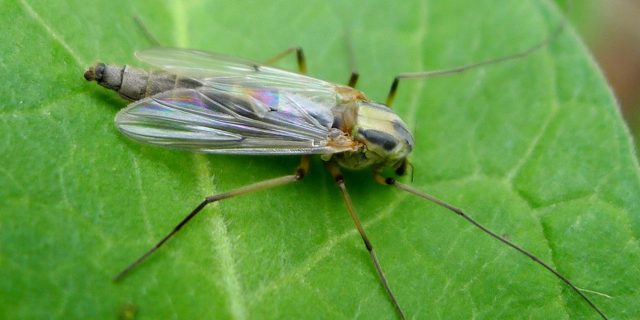27
Apr
Pesticide Concentration through Metamorphosis Contaminates Birds and Bats

(Beyond Pesticides, April 27, 2022) Pesticides can accumulate in aquatic fly larvae, be retained through metamorphosis, and represent a source of chronic pesticide exposure to birds and bats, according to research published in Environmental Science and Technology earlier this month. As population declines among these critical wildlife continue to mount, findings like these highlight the complex ways in which human activities are further stressing natural systems. Pesticide reviews conducted by the U.S. Environmental Protection Agency (EPA) are limited to an outdated set of studies conducted by the pesticide industry, and generally reject and dismiss emerging science from independent literature. This myopic focus on industry studies has brought widespread contamination to the natural world that necessitates wholescale changes at EPA through Congressional action.
With widespread acknowledgement that older pesticide chemistries, such as organochlorines like DDT and aldrin, bioconcentrate in living organisms, researchers aimed their study at present use fungicides and herbicides that have not yet undergone similar scrutiny. This includes seven fungicides—azoxystrobin, boscalid, cyflufenamid, fluopyram, tebuconazole, pyrimethanil, and trifloxystrobin—and two herbicides—napropamide and propyzamide. The study notes that formulated end use products, rather than technical grade active ingredients, were used in order to best mimic real world exposure conditions.
Larvae of the nonbiting midge, Chironomus riparius, were subsequently exposed to three different levels (low, moderate, high) of each of the aforementioned pesticide products in a microcosm for 14 days. A control group was left unexposed. Scientists found that all larvae exposed to any level of pesticide accumulated that pesticide in their body by the end of the test. The control group did not bioconcentrate any pesticide.
Exposed midge larvae were then allowed to metamorphosize into adults. After this process, researchers again tested the level of pesticide concentrated in the flies. Adult flies in the medium and high exposure levels all retained pesticides in their bodies, and five of the nine pesticides (trifloxystrobin, tebuconazole, boscalid, propyzamide, azoxystrobin) were also found in adult midges exposed to the lowest treatment levels.
Sex-specific differences were found among the level of pesticide retained through metamorphosis. In general, females retained higher pesticide levels than male flies. However, the level in female flies generally decreased over the course of their life, likely as a result of metabolic processes and egg laying. Male flies generally retained the same concentration over the course of their life. Researchers did note that certain pesticides, such as propyzamide and tebuconazole, increased in concentration in adulthood, which the authors attribute in part to bioamplification due to body mass loss after metamorphosis.
To determine how this contamination moves up the food chain, researchers estimated the flux of pesticides that would make its way into the environment from the low treatment level, in order to provide the most realistic and conservative estimate. It was determined that roughly 10.4−94.0 ng/m2 of pesticide per year is moving from aquatic to terrestrial ecosystems as a result of this process. This is a significantly higher amount than other studies, excluding these data, have estimated for the transition from waterbodies to land, which generally indicate a range of 0.4 to 26.8 ng/m². Ultimately, the researchers find that bats and birds feeding on contaminated midges could result in low to moderate chronic pesticide exposure.Ultimately, the researchers find that bats and birds feeding on contaminated midges could result in low to moderate chronic pesticide exposure.
“Considering the declines in bird and bat populations coinciding with increased pesticide use in recent decades, a better understanding of the potential dietary exposure to organic pesticides is of great relevance,” the authors note.
The ability for pesticides to “pass through” pest or prey species and result in harm to species higher up in the food chain is not a new phenomenon. It is perhaps most widely known in the context of DDT’s ability to bioaccumulate up the food chain and result in thinning egg shells for birds of prey. Recent studies have highlighted this process occurring in agricultural settings with the use of neonicotinoid seeds. Scientific studies have reported slugs unaffected by the pesticide killing predator beetles due to high levels of bioconcentrated insecticide.
Pesticides do not simply stay where they are sprayed. They make their way into every facet of an ecosystem, with impacts that are difficult to discern, yet have critical implications for long-term fitness and sustainability. Despite this, regulators at EPA have consistently failed to look comprehensively at the broader ecosystem effects and trophic cascades that can occur from even low levels pesticide contamination in the environment. As a result, advocates are urging Congress to reform EPA through legislation like PACTPA and SAPA, which while aimed at protecting children and pollinators, would enact important reforms that would safeguard overall public health and environmental sustainability. Take action today to urge your member of Congress to cosponsor PACTPA and push for broader reforms to pesticide law.
For more information about the ways pesticide contamination can cascade through ecosystems, see Beyond Pesticides wildlife webpage and the article in Pesticides and You: Pesticide Use Harming Key Species Ripples Through the Ecosystem.
All unattributed positions and opinions in this piece are those of Beyond Pesticides.
Source: Environmental Science and Technology, ScienceDaily










